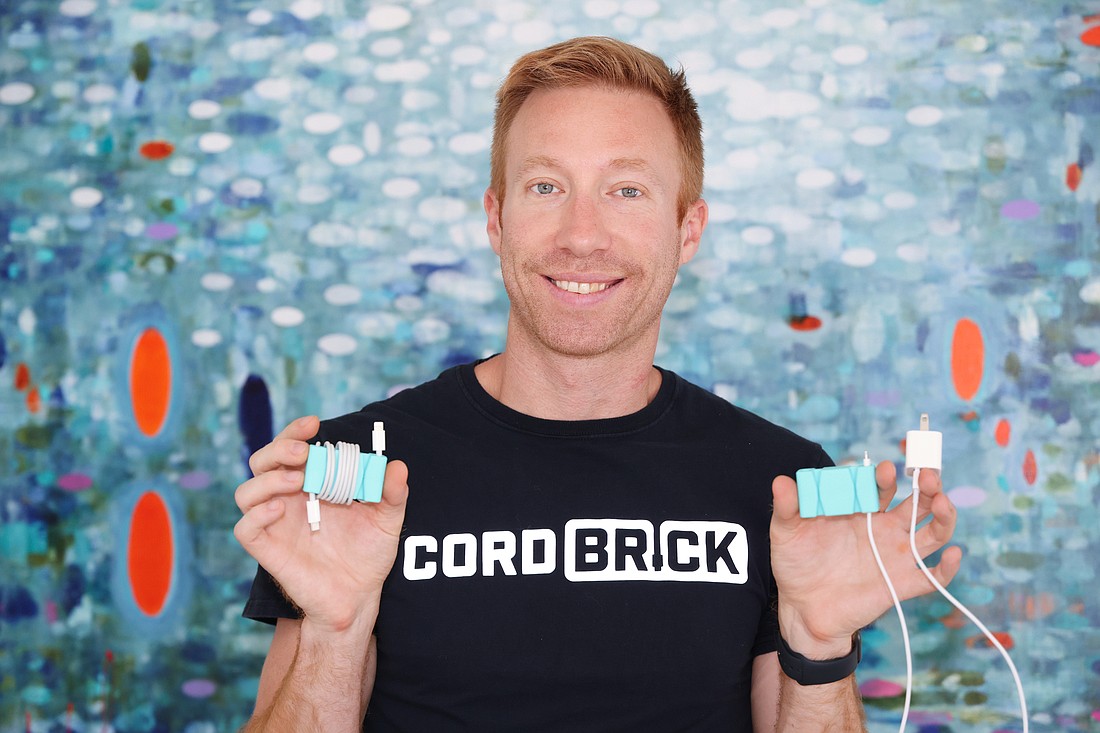- April 4, 2025
-
-
Loading

Loading

It’s a scenario many of us probably struggle with each day: you need to charge your phone overnight but want it in your bedroom. The only outlet available for charging is hiding behind the bed or a piece of furniture. So you wedge the charging plug in there, and every night you need to fish the cord out of the crevice it continually slips into when not in use.
Naples resident Nick Barrett, too, was tired of his phone charger cord constantly falling off his nightstand and out of reach.“I looked at what was available, and there wasn’t anything that seemed to be what I was looking for,” he says.
So he set out to make something.
That began an almost two-year journey to design and manufacture a product he calls CordBrick, to help keep charging cords in reach. He began prototyping efforts in June 2020, officially formed CordBrick LLC in September 2020 and logged his first sales in December 2021.
What he created is a silicone rubber, steel-weighted device that can wrangle and organize multiple charging cords. It not only holds charging cords in place for easy access. It can also serve as a cord management tool where cords unwrap untangled and a utility tool for propping a phone up for photo taking or video viewing.
Barrett had help from friends, family, and trusted advisors along the way, who have provided both guidance and financial support (he received more than $100,000 of seed capital from friends and family plus a recent $50,000 risk-free loan) to make his vision a reality. “Most people have never taken something from conception to market,” says Barrett, 35. “It’s a lot more challenging than I originally thought.”
The manufacturing side — CordBrick is made in China, which he calls tough decision but right for the business — of the equation took a lot to figure out. “You’ve really got to make some considerations and compromises when you’re manufacturing to fit the efficiency and economies of scale and get the cost where you need it,” Barrett says. “At the same time, you’ve got to get the functionality of the product where you feel comfortable and confident in it. It’s a balancing act.”
Barrett obtained a design patent for the product and is in the process of filing for a utility patent. "If you can protect what you have, or at least deter people from attempting or thinking it over a little bit, you may have some more success,” he says. “Especially in the early going, when businesses don’t have the capital to be filing lawsuits.”
He also thinks holding patents for CordBrick will be beneficial when he begins seeking investors, something he plans to do around the end of this year.
Barrett began by selling the product in person, taking it to flea markets to see how customers responded. “People were buying them the first day I started selling them,” he says. “I don’t think I ever sold less than 15 in a day…If the product wasn’t good enough or selling, we wouldn’t have ordered more and we would have changed it. But we didn’t need to: It sold great and we got a great response and great feedback.”
Sales actually increased from January to March 2022, a bit of a surprise for Barrett. “That increase after the new year was really encouraging, to see that people wanted the product and it wasn’t just a holiday gift,” he says. “We saw repeat customers and got tons of happy email responses and thank yous. And there have been no returns to date — and I don’t expect any as well.”
He’s now focusing on selling CordBrick through his website (cordbrick.com), where it retails for $11.99 and comes in seven colors plus a glow-in-the-dark option. Under consideration: a bundle price for three or five that offers a slight per-piece discount. He’s also developing packaging for potential future retail sales. On the marketing side, Barrett’s working with public relations and social media pros to get the word out about CordBrick and create videos and other content to showcase the product.
And that’s not all: Barrett sees the potential to add features to CordBrick and expand the product line. He also thinks CordBrick could have a lot of success as a promotional product. “It’s a great product for business logos,” he says. “It’s not like a coffee cup in a cabinet or even a pen or something you might not use. It should be sitting there out in view.”